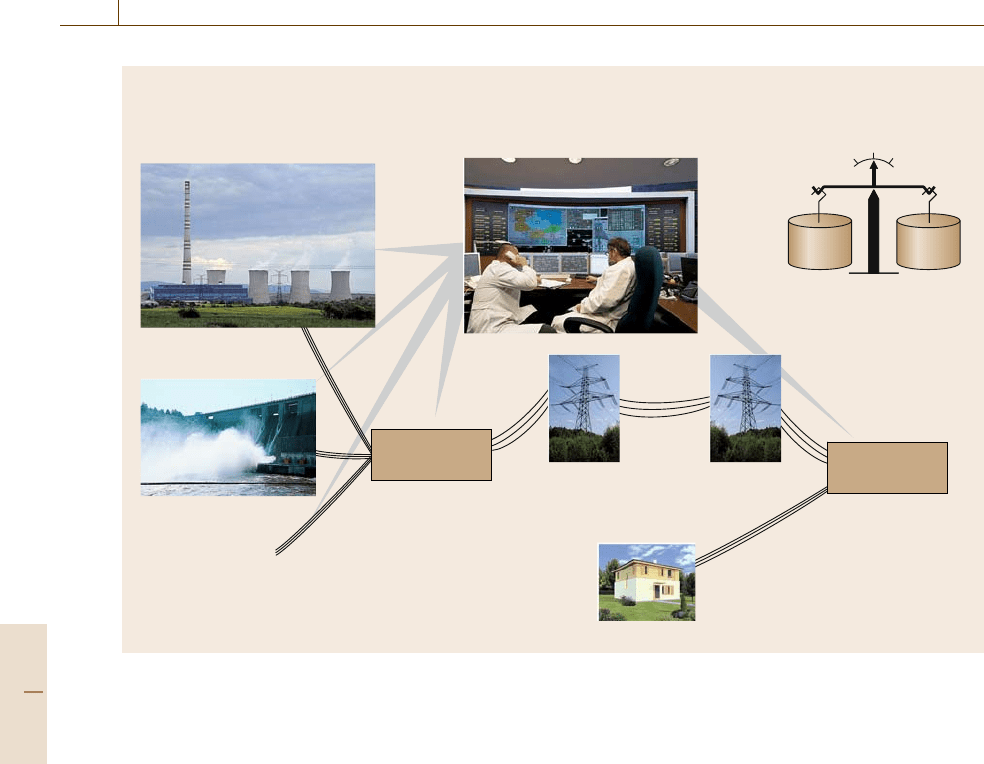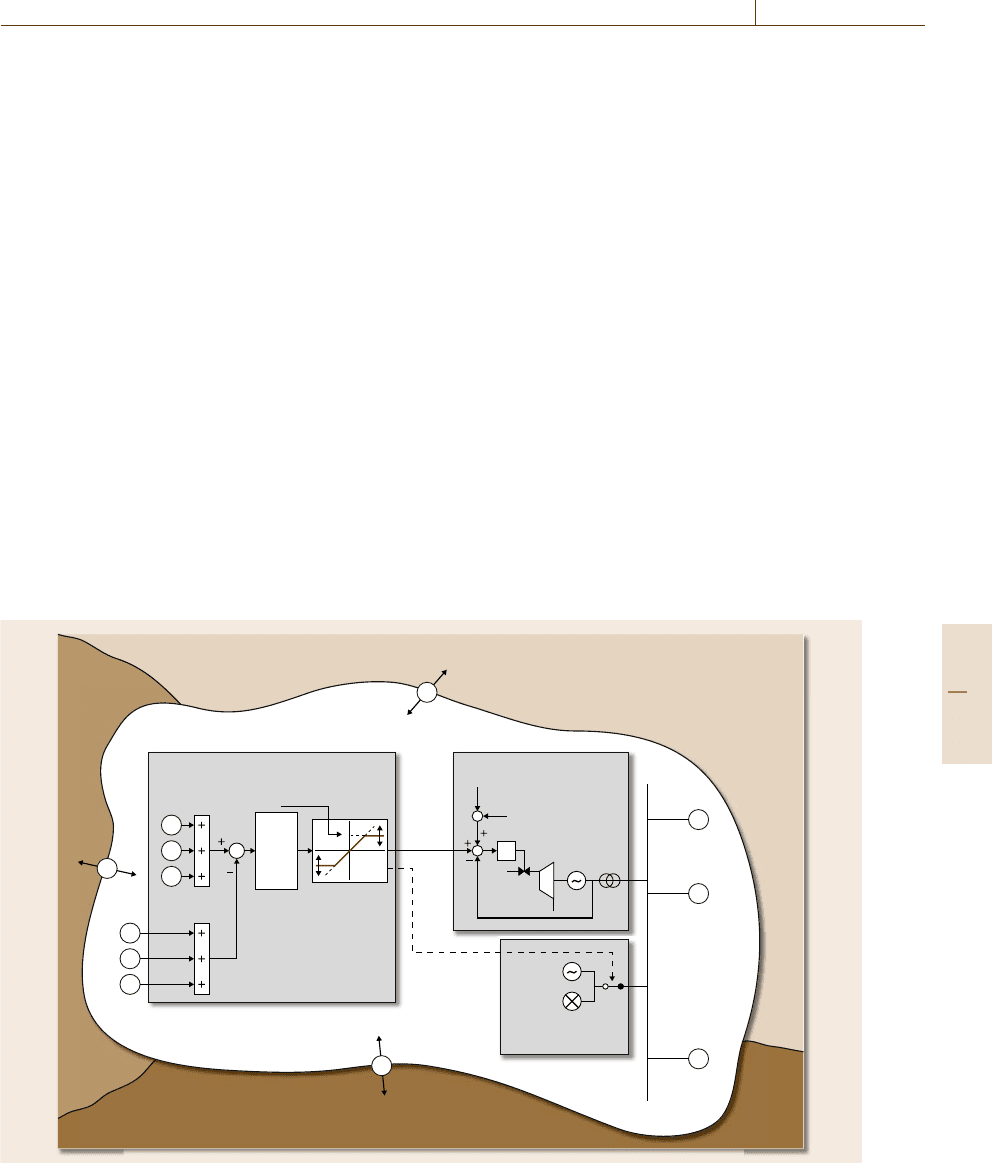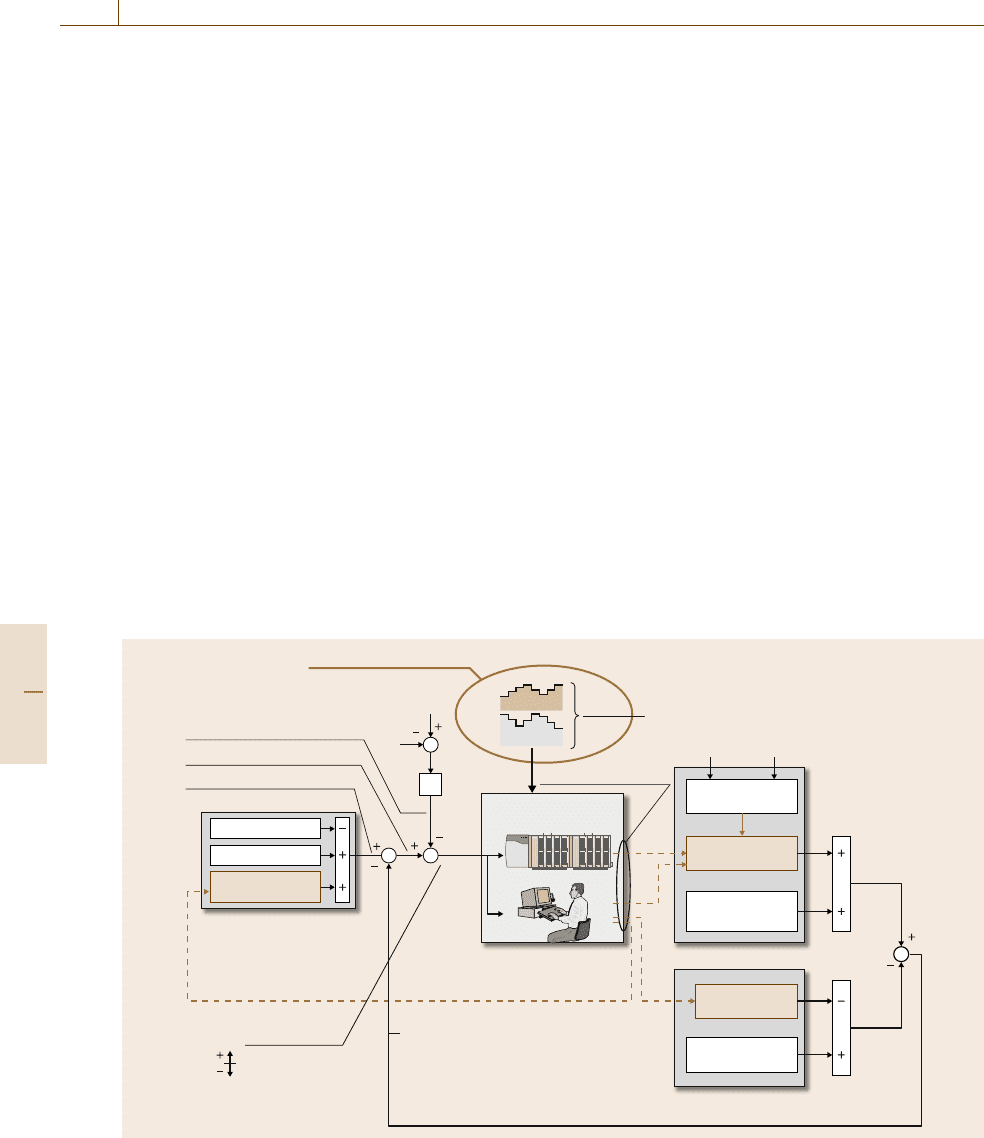Nof S.Y. Springer Handbook of Automation
Подождите немного. Документ загружается.


Control System for Automated Feed Plant 64.7 Software Design: Theory and Application 1135
One of the major tasks to be efficiently implemented
is the correct management of timing. The chosen solu-
tion was to use only one timer variable for all SFC-type
programs that is started when automatic mode is cho-
sen. In all SFC programs that need timing comparisons,
the solution adopted was to read this global timer as
necessary and make the desired calculations of time
passed. Other tested solution, using special timing func-
tions, like timer on (off) delay did not give expected
results in SFC programs, but performed well in LD dia-
grams. When the automatic mode ends, the global timer
is stopped and reset in order to avoid the situation in
which the timer could reach its maximum and overflow.
The timer is not needed in the manual mode.
Another special request was to minimize as much as
possible the production time, in order to increase pro-
ductivity. The solution chosen to achieve this goal was
to extract the cereals immediately after weighing ma-
chine 1 is unloaded into the transporting system. In this
way no time is lost; while the milling machine is pre-
pared to receive material, the weighing machine 1 is
emptied without any delay. In Fig. 64.4 an example is
shown of how the timer-off delay function block is used
in a LD program.
Because the impulseduration of variable b
SEL1 op
(starts a motor rotating clockwise) is too short, it was
extended by 500ms. In the second line of the diagram
you can see that the command is reset when:
•
500ms has passed or the confirmation from the mo-
tor’s contactor arrived.
•
The motor reached the corresponding limit.
•
Confirmation from the counterclockwise contactor
is not active (failure situation).
In thisway the operator must only start the movement of
a motor and the controller automatically stops it when
one of the conditions is fulfilled.
Another job to be correctly managed was the emer-
gency status. Because of the nature of the installations
of the factory, there are frequent situations when the
product process must be immediately interrupted (ex-
tractor clogging, transporters stuck, and so on).
When an emergency occurs (that could not be de-
tected automatically) the operator must stop all the
processes immediately by simply clicking a button, im-
plemented in the user interface. Inside the programs,
almost all the steps verify the status of the emergency
button and the status of several sensors. When an emer-
b_SEL1_op
l_sel1_cl
c_sel1_op o_sel1_op
c_sel1_cl
R
b_sel1_op
timrsib11
t#500ms
TOF
IN
PT
Q
ET
timrsib11.Q
Fig. 64.4 Automatically stopping a motor in an LD program
Step2
Step9
Step14
E
val_oil_co
val_oil_co
TRUE
val_Prem_ emergency_button
Step10
Step14
E
TRUE
Step14
Step2
EX
NOT
(emergency_button)
reset_but
Init
Fig. 64.5 Managing emergency situations in SFC
gency is detected, all SFC programs stop in their current
step. Depending on the gravity of the situation, the op-
erator has the possibility to resume the process from the
point where it was stopped or to reset all the programs
(Fig.64.5).
Once can see that step 2 has four conditions of tran-
sition. The first is the normal behavior of the process,
conditions 2 and 3 appear when some material is miss-
ing in the bin, and the fourth is true when the operator
presses the emergency button on the interface screen.
The latter three transitions lead the program to an emer-
gency step 14, from wherethe graphcan evolve to step 2
(resuming the program) or the Init step, sending the
program back to its initial status.
Part G 64.7

1136 Part G Infrastructure and Service Automation
64.8 Communication
Usually PLCs communicate with a PC by means
of a serial port (RS232 or RS485) or an Ether-
net interface (usually available only in more ex-
pensive and newer PLCs). Various protocols are
implemented in the PLC in order to communi-
cate (such as Profibus, transmission control protocol
(TCP)/internet protocol (IP) and others). Sometimes
the programmer must develop his own commu-
nication protocol if none is implemented in the
PLC.
ThinkIO controllers have already installed an OPC
server that can be used to exchange data between the
PLC and other computers connected in the same net-
work. This is a very useful feature because several PCs
can communicate with the controller and can be used
to monitor all the production process, to configure the
recipe, and even to send commands to the installations
(if the program allows this).
At this time one PC program was developed, with
the following behavior:
•
The operator can edit, save, load recipes, and send
them to the PLC on the network, acting as an OPC
client.
•
Reports are printed at the printer after each charge
finishes.
64.9 Graphical User Interface on the PLC
In a Codesys development program the user can create
as many visual interfaces as needd and run this inter-
faces directly from the ThinkIO PLC. Practically a PC
is not needed anymore to supervise the control process.
Raw material bins
Press bins
SGC
EC
UMP_PMX
GOL_PMX
ID
I
D
ID
Product storage bins
Transporter 1 Transporter 2
L G L1 G1 L2 G2 L3 G3
F1 F2 F3 F4 F5 F6 F7 F8
Tank
empty
Grin-
ding
Premix
Time
40s
Left
15s
Weight
200kg
Oil
Time
25s
Left
10s
Weight
70kg
Mill
Mixing machine
Time
2m15s
Time left
1m10s
Status OK
Restart Auto
Resume
Start
Feeding
Load Recipe
Recipe Nr. 10
Charge Nr. 5
Press
Weight 1
1200kg
B5
4.0
2.0
0
B1
4.0
2.0
0
B6
4.0
2.0
0
B2
4.0
2.0
0
B4
4.0
2.0
0
B8
4.0
2.0
0
B3
4.0
2.0
0
B7
4.0
2.0
0
Fig. 64.6 Software view: main production area
For this projectfive visual screens weredeveloped, each
representing a specific area of the factory; for exam-
ple Fig. 64.6 shows the main area of the factory, with
its complicated transport system (formed by conveyors
Part G 64.9

Control System for Automated Feed Plant 64.11 Environment Control in the Chicken Plant 1137
and elevators), storage bins for raw material and final
product, and other machines. Buttons on the screen can
be clicked with the mouse and will start/stop some mo-
tors. The color of the objects usually indicates its status
(started, stopped, full, empty, and so on), according to
the values of associated sensors.
In this screen the operator can see information from
all the sensors in the area, even the values from the
weighing machines. Also the operator can manually
command the execution elements from this area, e.g.,
can start automatic production or stop it by pressing the
emergency button.
64.10 Automatic Feeding of Chicken
All this fodder production obtained in the feed plant is
destined for feeding growing chicken in special farms.
Chicken growth requires two separate processes: the
supply of food and water to them and control of the en-
vironment. The chickens are prepared for sacrifice after
40days, which is the optimum period for the chickens
to be large enough and have tender meat. The control
system of the factory must be very efficient in order
to minimize the cost per kilo of meat. Two factors in-
fluence correct growth of chickens: food quality and
environmental parameters (temperature and humidity).
It is very important that the chicken do not waste energy
adapting to the environment, so temperature and humid-
ity control must be very accurate. Environment control
strategy is different from summer to winter.
The process of supplying food and drink is not very
complicated. There are sensors that check if there is
Fig. 64.7 The feeding system
food in the plate; when the plate is empty the control
system starts the motors of the conveying system and
stops them after a specific period of time. There is also
an alarm system when the tank reaches a lower limit
(Fig.64.7).
64.11 Environment Control in the Chicken Plant
Environment control has to be the most accurate. Tem-
perature and humidity must continually be maintained
inside a specific range of values that differs from one
day to another. To fulfil this, gas burners and fans are
used to ventilate the interior with fresh air. To achieve
a good distribution of temperature many small burn-
ers are used instead of fewer larger ones. Because the
outside temperature differs between day and night, not
all capacity of the fans is needed all the time. To ad-
just this, variable-frequency drive (VFD) speed control
is used. A special situation occurs on cold days when,
even with no fan speed, the air flow is too strong to
maintain the temperature. There are three blowers and
normally all of them have to work for a good dispersion
of fresh air. Anyway there is the possibility to manu-
ally select the operation of each blower. Another option
is to use dumpers in each fan to control the opening of
the windows. The inside temperature is controlled by
a proportional–integral–differential (PID) software al-
gorithm combined with control of the dumpers when
needed. This is a continuous process and above it
there is a batch process that provides the set point for
temperature controller according to a temperature di-
agram. Usually this system is sufficient also to keep
O
2
within prescribed limits, but it is not sufficient for
humidity all of the time. The behavior of the indoors
environment is for increasing humidity, so controlled
opening of windows succeeds in maintaining the de-
sired conditions.
Here the processes are minor, but the combination
of a continuous process with a batch one does not re-
sult in a simple system. The performance of controlling
these parameters combined with the provision of appro-
priate food for each stage makes the difference between
companies. Another important influence on system per-
formance is the positioning of temperature sensors,
which should be uniformly distributed throughout the
area.
Part G 64.11

1138 Part G Infrastructure and Service Automation
64.12 Results and Conclusions
There were two important requirements to be accom-
plished by this automation system:
1. The ratio between different components contained
in a final product had to be very close to the pro-
grammed values (maximum 5% error).
2. The quantity of final product must also be close
to the programmed total quantity (2–3% error was
requested).
After several weeks of system testing the results
were as follows:
•
Condition 1 was fulfilled, and the error was very
small (2%).
•
Final quantity was about 5% more than the desired
quantity, because of estimated extraction, small
losses in transporting system, and so on.
The solution adopted was to slightly reduce the scales
for calculating the weight values for the weighing
machines until the resulted quantity was within ap-
proximately 2% of the desired value. At that time the
automation could be declared finished, with very good
results.
We believe that the solution chosen for this auto-
mated system is very modern and has several advan-
tages over what one might call classical solutions using
other PLC models [64.2]:
•
Process control and supervision do not require a PC,
as all programs and visual interfaces run on the
PLC.
•
Fast and reliable network communication with PCs,
by OPC server, in contrast to the widely used
serial RS232or RS485communication inother con-
trollers.
•
The short working cycle due to fast processor.
•
The extremely large number ofI/O modules that can
be managed (hundreds of digital signals monitored)
by a single controller.
Future work will be to design a supervising user inter-
face program that can access the controller directly the
from internet [64.3], so, e.g., the owner of the factory
can be informed about production flow even when far
from the factory.
64.13 Further Reading
•
T. Borangiu, F.D. Anton, S. Tunaru, A. Dogar,
N.A. Ivanescu, N. Manu: High speed real-time
robot vision design for flexible part feeding, Proc.
14th Int. Conf. Robotics, Alpe-Adria-Danube Re-
gion RAAD’05 (2005) pp.337–345
•
N. Ivanescu, S. Brotac, A. Rosu: Modern solution
for controlling combined fodder plant, IMS (2007)
pp. 236–241
References
64.1 T. Borangiu: Sequential Controllers and Micropro-
gramming (Polytechnical, Bucharest 1993)
64.2 N. Ivanescu, S. Brotac, T. Borangiu, A. Rosu: Mod-
ernizing a Fodder Plant, Proc. IEEE SMC Int. Conf.
Distrib. Hum.-Mach. Syst. (Atena 2008) pp. 543–
548
64.3 N. Ivanescu, S. Brotac, T. Borangiu: A distributed
and configurable architecture for controlling in-
dustrial processes, IMS, 132–137 (2001 )
Part G 64

1139
Securing Elect
65. Securing Electrical Power System Operation
Petr Horacek
Automation in power systems has a very long
tradition. Just recall the flyball governor in a
steam engine and it becomes clear that power
people have been using control principles and
instruments for more than a century. There are,
however, new challenges in power generation
and transmission concerning the security and
efficiency of those services that require the at-
tentions of both theoreticians and practitioners.
These challenges are the subject of this chap-
ter. The power failures that affect large grids
from time to time show that system collapses
are not simply a subject of academic debate.
Power network operating reliability has become
an issue that any country must make a top
priority. The reliability of a power system de-
pends for the most part on the quality of the
decisions made, both automatically and manu-
ally. The term power system is very broad, and
we focus here on the power system backbone,
electric power transmission, and its operational
reliability, particularly when automatic control
plays a vital role. The content of the chap-
ter remains interdisciplinary, spanning power
systems, automation and economy, as changes
resulting from the opening of the markets and
permanent power system restructuring affect its
operation.
65.1 Power Balancing ..................................1141
65.1.1 The Problem .............................. 1141
65.1.2 Who Performs Power Balancing? .. 1141
65.1.3 Means of Balancing .................... 1142
65.1.4 Power Balancing Mechanisms
Within the Control Area............... 1143
65.1.5 System Frequency ...................... 1145
65.1.6 Primary Frequency Control .......... 1145
65.1.7 Secondary Frequency
and Power Control...................... 1148
65.1.8 Tertiary Reserve ......................... 1150
65.1.9 Quick-Start Reserve .................... 1150
65.1.10 Standby Reserve......................... 1150
65.1.11 Planning Reserves ...................... 1150
65.1.12 Performance Criteria................... 1151
65.2 Ancillary Services Planning ....................1153
65.2.1 Stochastic Model
of Area Control Error ................... 1154
65.2.2 Minimal Needs of AS ................... 1155
65.2.3 AS Bids
from Generation Companies ........ 1156
65.2.4 Procurement of Ancillary Services . 1157
65.2.5 Availability
of Self-Regulation Power ............ 1157
65.2.6 Monte Carlo Simulation
of Power Balancing .................... 1157
65.2.7 Control Performance Evaluation ... 1159
65.2.8 Case Studies .............................. 1159
65.2.9 Related Topics ........................... 1161
References ..................................................1162
There areseveral textbooks thatsurveythe power indus-
try – covering a regulated utility structure and the major
concepts of deregulation, the history of electricity, the
technical aspects, and the business of power – that are
recommended for those who would like to get a broader
picture of the industry [65.1].
Unlike other commodities, electricity generally can-
not be stored for later use; it must be used as it is
generated. Therefore, generation must be dispatched
instantaneously to respond to real-time changes in con-
sumers’ demand for electricity. To support these energy
flows, grid operation encompasses scheduling and man-
aging flows overtransmission linesand coordinatingthe
operation of the transmission network equipment.
This chapter introduces methods for securing the
operation of an electrical power system network, as
Part G 65

1140 Part G Infrastructure and Service Automation
Wind farm
High voltage
transmission lines
Distribution
substation
Generation
Thermal power plant
Homes and business
Distribution lines
Generation
Load
and
interchange
MW MW
System Operations:
Generation-load balancing
Maintaining scheduled interchanges
Supporting interconnection frequency
Transmission
station
Hydro power plant
50/60 Hz
Fig. 65.1 Area system control objectives
shown schematically in Fig. 65.1, in terms of active
power balancing through both automatic and manual in-
terventions. Unlike a traditional control problem, where
the task is to synthesize the control law for a given
plant/process and constraints, our problem is to deter-
mine the constraints for a given control law so the
control system has the right freedom in taking proper
actions. Constraints appear in the form of regulat-
ing/balancing power reserves that have to be planned
and reserved in advance so that the area control error,
the instantaneous difference between the actual and the
reference value for the power interchange of a control
area (also known as the unintentional deviation), is kept
within reasonable bounds. Balancing power is accessi-
ble in the form of ancillary services (AS), as provided
by power-generating companies and traded in the mar-
ket. Balancing power reserve activations are variables
manipulated by a system operator (SO) which is re-
sponsible for power balancing in a geographical area.
This is a complex task in a liberalized market environ-
ment. Power reserves, or rather the ancillary services
providing the reserves, must be carefully planned and
purchased so that the SO is able to use them when
required.
The chapter introduces a power-balancing prob-
lem, starting from a review of the basic concepts of
controlling synchronous generators connected to large
grids, such as the technical means for power bal-
ancing that are available, how the power balancing
is distributed throughout the network, and who is in
charge of the task. Next, criteria related to the suc-
cessful completion of the balancing task are revealed
for two large grids: the North American and Euro-
pean grids. Later, the principle of a decision-support
tool used by a SO for year-ahead planning and pro-
curement of ancillary services is described. A method
originally designed for the area of the UCTE,theUnion
for the Co-ordination of Transmission of Electricity,in
which 23 European countries are synchronously inter-
connected, can be made applicable to other conditions
after modification. Some of the challenges associated
with continuously evolving power systems, where au-
tomation plays an important role, are discussed at the
end.
Part G 65

Securing Electrical Power System Operation 65.1 Power Balancing 1141
65.1 Power Balancing
In any electrical system, the active power genera-
tion and consumption must be balanced to prevent
major losses of material and even human lives, as
large or long-lasting power deviations may ultimately
lead to blackouts if the balance moves out of con-
trol. Disturbance to this imbalance, first noticed as
a system frequency deviation, will be offset initially
by the kinetic energy of the rotating turbo genera-
tors and motors connected to the grid. The capacity
of kinetic energy storing elements is insufficient to
maintain the power equilibrium in real time. Gener-
ation units must be manipulated to conduct power
balancing so that the network user is not affected
by demand changes or generation and transmission
outages.
65.1.1 The Problem
Secure operation of a transmission system and pre-
vention of blackouts is an issue of rising importance
for countries with deregulated electricity markets. The
liberalization of electricity markets is a process that
started a while back and is still in progress in many
countries [65.2–5]. The basic motivation for this liber-
alization is to enable more effective power generation
as well as investment and expansion planning than
would occur in a traditionally vertically integrated
electricity supply industry. On the demand side, end
users are free to choose their supplier and to negoti-
ate their contracts. On the supply side, producers can
sell their electricity to any other market players. It is
believed that this could possibly result in lower electric-
ity prices. However, links between physics and business
practices must be carefully maintained to ensure that
enough balancing power is available when required,
so the performance criteria of the system is guaran-
teed at the lowest cost possible. In another words,
there is the need for active power balancing mecha-
nisms, reserve planning and purchasing, which is the
task performed by a balancing authority (BA) responsi-
ble for power balancing in an area within the electrical
grid.
The BA is an electrical power system or com-
bination of electrical power systems bounded by
interconnection metering and telemetering.The BA bal-
ances the supply and demand within its area, maintains
the interchange of power with other balancing authori-
ties, and maintains the frequency of the electrical power
system within reasonable limits.
65.1.2 Who Performs Power Balancing?
All grid operators are charged with maintaining the
reliability of the systems under their control. Within
their footprints, SOs oversee and direct the high-
voltage bulk-power system and coordinate electricity
generation to maintain a reliable supply of electrical
power to electricity users. SOs provide critical reliabil-
ity services, including outage coordination, generation
scheduling, voltage management, ancillary services
provision, load forecasting, and more. They improve
reliability in part because of their large scope – by
consolidating control areas, they reduce the number of
decision makers managing the grid, which simplifies
coordination and improves reliability.
System operators oversee grid functions and make
necessary corrections to ensure reliability on a minute-
to-minute basis around the clock. SOs may organize
wholesale markets for energy and ancillary services,
such as reserves, frequency and voltage regulation, and
voltage support. These ancillary services help ensure
reliability and help system operators react quickly and
effectively to changing conditions on the grid, such as
the loss of a generating unit or a transmission line.
Independent system operators (ISOs) and regional
transmission organizations (RTOs) in North America
and transmission system operators (TSOs) in con-
tinental Europe have the size, scope, scale, tools,
information and authority to be effective grid managers.
ISOs/RTOs/TSOs have near-identical responsibilities
for managing the grid over a large geographic scope and
operating markets to some extent.
Anyone who would like to get more details on
the definitions, terminology, responsibilities and pro-
cedures that a particular system operator should use
an internet search engine and look for the key word
Grid Code. The Grid Code is an industrial textbook
that every system operator must follow every day; it is
carefully and regularly updated.
North America
There are three synchronous areas in North America:
the Western, Eastern and Texas Interconnections. In
each interconnection thereare ISOs(BAs)and localbal-
ancing authorities (LBAs) that communicate. As part of
operating the grid, ISOs/RTOs meet or exceed the re-
liability standards set by the North American Electric
Reliability Corporation (NERC) and its regional coun-
cils. Adhering toNERC standards ensuresthat the entire
Part G 65.1

1142 Part G Infrastructure and Service Automation
Table 65.1 Classification of ancillary services
Generic AS Description
Continuous regulation Provided by online resources with automatic controls that respond rapidly to
operator requests for up and down movements. Used to track and correct minute-
to-minute fluctuations in system load and generator output.
Energy imbalance
management
Serves as a bridge between the regulation service and the hourly or half-hourly
bid-in energy schedules; similar to but slower than continuous regulation. Also
serves a financial (settlement) function in clearing spot markets.
Instantaneous
contingency reserve
Provided by online resources equipped with frequency or other controls that can
rapidly increase output or decrease consumption in response to a major distur-
bance or other contingency event.
Replacement reserves Provided by resources with a slower response time that can be called upon to
replace or supplement the instantaneous contingency reserve in restoring system
stability.
Voltage control The injection or absorption of reactive power to maintain transmission system
voltages within required ranges.
Black start Generation is able to start itself without support from the grid and has sufficient
real and reactive capability and control to be useful in system restoration.
grid in North America operates at appropriate levels of
reliability.
The ISO calculates the area control error (ACE;
described later in the chapter) for its balancing author-
ity area and measures the ACE against the applicable
balancing standards. There are also local balancing au-
thorities that are responsible for actual interchange.
To summarize, the ISO assumes the role of a BA,
planning authority, reliability coordinator, market oper-
ator and tariff and interconnection administrator. LBAs
take care of load and resource asset management, tie-
line checkout and emergency operation coordination.
ISO guaranteeseffectiveuse ofassets, includingthe dis-
patch of energy and the dispatch of reserves (including
contingency reserves). The ISO organizes the energy
and operating reserve market (also known as the ancil-
lary services market), regulation and response services,
and contingency reserves.
Europe
In continental Europe there is an equivalent to the
American ISO/RTO Council, the UCTE. The UCTE
also defines standards the members must adhere to, so
the UCTE plays the role of the NERC as well. The
difference is that members of the UCTE are system op-
erators that are each responsible for a single control
area (synchronously interconnected within the UCTE)
and own the transmission assets. In many countries, the
transmission system operator (TSO) plays the role of
the BA.
65.1.3 Means of Balancing
Power reserves are provided by generators and distribu-
tors in the form of ancillary services. By definition, an-
cillary services are interconnected operations services
influencing transfer of electricity between purchasing
and selling entities which a balancing authority must
include in an open access transmission tariff.
Ancillary services are a collection of secondary
services offered to help to insure the reliability and
availability of energy to consumers. These services
include regulation and contingency reserve (spinning,
supplemental – nonspinning). The contingency reserve
services are often referred to as operating reserves.
Ancillary services insure that capacity is available
when needed to maintain secure power system opera-
tions due to a loss of or increase in load and resources.
A contingency is a trip of a transmission line or gen-
erator, a loss of load, or some combination of these
events. This contingency in turn causes other prob-
lems, such as a transmission line overload, an over- or
undervoltage in an area, over- or underfrequency, or fre-
quency instability. Contingency reserves are a special
percentage of generation capacity resources held back
or reserved to meet emergency needs.
Part G 65.1

Securing Electrical Power System Operation 65.1 Power Balancing 1143
AS arrangements vary considerably across electric-
ity markets. Let us introduce six generic AS that are
necessary for maintaining system reliability and se-
curity in electricity grids. Ancillary services required
during normal conditions are continuous regulation and
energy imbalance management. Instantaneous contin-
gency reserve and replacement reserve are services
that are used during system contingencies. Ancillary
services that do not apply to active power balanc-
ing directly are voltage support and black start. The
generic AS categories are described more precisely
in Table 65.1.
Ancillary service markets are critical to power sys-
tem security and reliability and, given the value that
customers place on reliable electrical services, their
overall value to society is quite high.
Each market incorporates all six generic ancillary
services, although the nomenclature, technical require-
ments and procurement details vary significantly. This
chapter assumes that we are working with a TSO, and
an area of the UCTE, in the European system, where
transmission ownership and system operation is man-
aged by a TSO as a single authority in the control
area.
Power
exchange
planned
Measured
Contracted
power reserves
Load
shedding
Transmission
system
operator
Domestic
production
Domestic
consumption
Grid
A
B
C
a
b
c
A
B
C
A, B, C
adjacent areas
synchronously
connected
P
production_plan
ΔP
balancing_by_producer
ΔP
TSO
Power balancing
control and
decision making
A
C
B
B
C
A
A
Fig. 65.2 Diagram showing the principle of power balancing ininterconnected areas (frequency control loops not shown)
The role played by the TSO in the real-time power
balancing can be understood from the overall block di-
agram in Fig.65.2, which shows the essentials of the
power balancing task while hiding the complexity of
the very large scale power system. The control area in
the center is synchronously connected to three adjacent
areas A, B and C, making an interconnection.
The task for the TSO is to acquire enough power
reserves in the form of ancillary services and activate
them in a timely manner in order to guarantee the lim-
its set on performance indices (standards) that evaluate
the quality of power balancing. The task must be solved
for the lowest cost possible. In this chapter, we de-
fine performance indices, describe the methods used in
planning, and show how the planned reserves are val-
idated. This chapter considers one year as the horizon
for ancillary services planning.
65.1.4 Power Balancing Mechanisms
Within the Control Area
What Is a Control Area?
A control area is an electrical power system that is
managed under a common automatic control scheme
Part G 65.1

1144 Part G Infrastructure and Service Automation
that maintains frequency by balancing load with pro-
duction. Historically, a utility ran its own control area,
regulating frequency, balancing load and generation,
purchasing energy and capacity, and maintaining op-
erating reserves as needed. Many large utility control
areas served smaller in-area and nearby utilities as well.
Today, some control areas exist to manage only gen-
eration, but most balance both generation and load. In
North America, many control areas that existed histor-
ically have been consolidated into ISOsorRTOsand
offer system balancing and management services that
the control area no longer had to provide itself.
Power Balancing
To operate a large power system and to create suitable
conditions for commercial electricity trade, it is nec-
essary to schedule the power to be exchanged at the
interconnection borders between the system operators
in advance. During daily operation, the schedules are
followed by means of the load-frequency control in-
stalled in each control area. Despite the functionality
of load-frequency control, unintentional deviations oc-
cur in energy exchanges. For this reason, unintentional
deviations are compensated for through methods of the
TSO in every control area.
To plan and purchase
Inadvertent interchange
Net scheduled interchange
Scheduled import
Primary frequency
control
Power reserve activation
Auto
Man
Balancing power
domestic
Power
generation
Load shedding
Domestic demand
P
programmed
P
measured
Scheduled export
Balancing power
from other areas
Set-point of foreign exchange
(scheduled exchange)
Consumption
Production
Frequency bias obligation
Net actual interchange
metered
BA's ACE
f
0
f
0
K
ACE
f
meas
f
meas
(Hz)
(MW)
MW
h
(MW)
(MW)
Unscheduled import
Unscheduled export
Δf
Range of balancing power reserves
(purchased ancillary services)
TSO/ISO
EMS
AGC
Fig. 65.3 Power balancing in the area as a feedback control system
Real-time power balancing of a control area is usu-
ally performed by both automatic control and manual
interventions from the TSO’s dispatch center. The en-
tire feedback control loop of a particular control area is
showninFig.65.3.
From the control theory perspective, the controlled
variable is the instantaneous value of the cross-border
power exchange P
measured
, which should meet its
scheduled value P
programmed
. Manipulated variables are
represented by various categories of regulation power
available in the form of ancillary services. Disturbance
variables influencing cross-border power exchange can
be divided into two groups: deterministic, e.g., im-
balances caused by trading strategies; and stochastic,
mainly random demand fluctuations and generator out-
ages.
The inputto the controller is the ACE, the difference
between the scheduled and actual cross-border power
exchange, corrected for the effect of the primary fre-
quency control so that the central controller does not
compensate for outages of generators located in adja-
cent control areas (for example).
The output of the central controller is to increase
or decrease power on the production side or, in the ex-
treme case, on the consumption side aswell. Despite the
Part G 65.1
